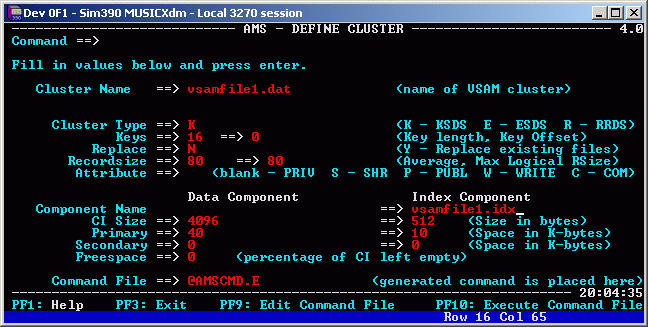
The required files are in update file misc8.arc for the MUSIC/SP Demo system.
To run the sample program, you must first use the interactive AMS (Access Method Services) utility to create the VSAM file. Before starting AMS, run the libspace command to check that your MUSIC system has at least 3000K free space in the Save Library. If space is low, perhaps you can delete some earlier archive files (misc1,arc, misc2.arc, etc.) Otherwise the AMS Rexx program does not work correctly, and you may get error messages "File i/o unusual condition 051" on the operator console. Start AMS and enter option 4 (allocate a cluster) in the command area, and press Enter:

This brings up the screen for allocating a new VSAM file. For a KSDS, there are 2 physical files: the data component (in this case vsamfile1.dat) and the index component (vsamfile1.idx). Enter the file options as shown here:

Press Enter, which should give output similar to the following:
Access Method Services WED NOV 23, 2005 20.10.56 *** 1) DEF CL(NAME( VSAMFILE1.DAT ) KSDS PRIV RECSZ( 80 80 ) KEYS( 16 0 )) - 2) DATA ( CISIZE( 4096 ) SP( 40 ) SECSP( 0 ) FREESPACE( 0 0) ) - 3) INDEX( CISIZE( 512 ) SPACE( 10 ) SECSPACE( 0 ) ) Command read, processing begins ... Cluster successfully allocated Data Component: $000:VSAMFILE1.DAT Index Component: $000:VSAMFILE1.IDX Command successfully completed, return code = 0 Command required 0.31 service units for execution End of file, command processing ends Highest return code = 0 Total execution time: 0.64 service units
Next, use the Editor to create the input file of 80-byte records in file mydata . In our sample, the key is the first 16 characters of each record. Make all the key fields different. The records can be in any order. For example:
record1key data part of rec 1 record2key blablabla record01key more data record3key 123 456 789 record1.5key and so on.
Then execute the sample program by typing $vsm:vsam.sample in the *Go command area. The output should be similar to:
000300 BYTES USED EXECUTION BEGINS VSAM SAMPLE PROGRAM ENDED NORMALLY
You can check the VSAM file by the following job, which uses the utility VSAM.COPYFRVS to copy the records from the VSAM file to the screen (prt):
/file ddname1 n(vsamfile1.dat) /file 1 prt /inc vsam.copyfrvs
The output should be like:
record01key more data record1.5key and so on. record1key data part of rec 1 record2key blablabla record3key 123 456 789 0000005 RECORDS COPIED FROM VSAM FILE
Note that the records have been sorted into key order!
Here is a listing of the sample program source file:
/SYS TIME=MAX
/FILE DDNAME1 NAME(MYDATA) SHR
/FILE DDNAME2 NAME(VSAMFILE1.DAT) OLD NORLSE
/LOAD ASM
*
* THIS SAMPLE PROGRAM READS DATA RECORDS FROM A SEQUENTIAL
* FILE ON DDNAME "DDNAME1" AND WRITES THEM TO A VSAM KSDS
* ON DDNAME "DDNAME2". IT IS ASSUMED THAT THE VSAM FILE
* HAS ALREADY BEEN CREATED AND INITIALIZED.
* THE INPUT RECORDS ARE ASSUMED TO BE OF LENGTH 80.
*
* AN OPEN ERROR CAUSES AN INVALID OP-CODE WITH R7=X'EE1' AND
* R0=OPEN ERROR CODE.
*
* AN ERROR WRITING TO THE VSAM FILE CAUSES AN INVALID OP-CODE
* WITH R7=X'EE2', R0=ERROR CODE FROM PUT, R15=RETURN CODE FROM PUT.
*
SAMPLE CSECT
REGS , THIS MACRO DEFINES REGISTERS
STM R14,R12,12(R13) SAVE REGISTERS
LR R12,R15 SET UP A BASE REGISTER
USING SAMPLE,R12
LA R14,SAVEAREA SET UP A SAVE AREA
ST R13,4(0,R14)
ST R14,8(0,R13)
LR R13,R14
* OPEN THE TWO FILES
OPEN (MYDCB,INPUT) OPEN SEQUENTIAL FILE
OPEN (MYACB) OPEN VSAM FILE, USING AN ACB
* GET ERROR CODE FIELD FROM ACB
SHOWCB ACB=MYACB,AREA=OPENERRC,LENGTH=4,FIELDS=(ERROR)
L R0,OPENERRC
LTR R0,R0 TEST FOR VSAM OPEN ERROR
BZ OPENOK BRANCH IF NO ERROR
* VSAM OPEN ERROR
LA R7,X'EE1' INDICATE INTENTIONAL P.I.
DC H'0' STOP JOB BY INVALID OP-CODE
OPENOK DS 0H
* READ LOOP: READ NEXT RECORD INTO "MYAREA"
READLOOP GET MYDCB,MYAREA READ RECORD USING QSAM
PUT RPL=MYRPL WRITE RECORD TO VSAM FILE
LTR R15,R15 TEST FOR WRITE ERROR
BZ READLOOP BRANCH IF NO ERROR
* VSAM ERROR: GET ERROR CODE FROM RPL
LR R5,R15 SAVE R15 RETURN CODE
SHOWCB RPL=MYRPL,AREA=REQERR,LENGTH=4,FIELDS=(FDBK)
L R0,REQERR GET ERROR CODE IN R0
LR R15,R5 RESTORE R15 RETURN CODE
LA R7,X'EE2' INDICATE INTENTIONAL P.I.
DC H'0' STOP JOB BY INVALID OP-CODE
* COME HERE WHEN END-OF-FILE ON INPUT: CLOSE THE FILES
EOF CLOSE (MYDCB)
CLOSE (MYACB)
* WRITE MESSAGE TO TERMINAL
WTO 'VSAM SAMPLE PROGRAM ENDED NORMALLY'
* RETURN TO SYSTEM
L R13,4(0,R13) RESTORE SAVE AREA POINTER
LM R14,R12,12(R13) RESTORE REGISTERS
BR R14 RETURN
* STORAGE AREAS
SAVEAREA DS 18F STANDARD SAVE AREA
OPENERRC DS F RECEIVES OPEN ERROR CODE
REQERR DS F RECEIVES ERROR CODE FROM RPL
MYAREA DS CL80 LOGICAL RECORD BUFFER
* DCB FOR SEQUENTIAL INPUT FILE
MYDCB DCB DDNAME=DDNAME1,DSORG=PS,MACRF=GM,LRECL=80,EODAD=EOF
* ACB FOR OPENING VSAM FILE
MYACB ACB DDNAME=DDNAME2,MACRF=(KEY,SEQ,OUT)
* RPL FOR REQUESTS ON THE VSAM FILE
MYRPL RPL ACB=MYACB,AREA=MYAREA,AREALEN=80,RECLEN=80, X
OPTCD=(KEY,SEQ,NUP)
END